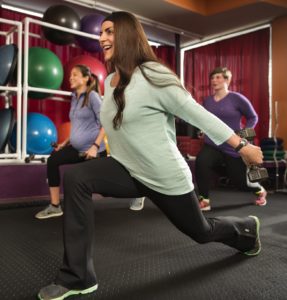Exercise during pregnancy is a hot topic these days. As a childbirth professional passionate about helping individuals stay active throughout the perinatal period, I have been excitedly witnessing the pendulum swing that is in progress—a swing from fear of exercise to empowerment through movement. Many pregnant people, who enjoyed a very physically active life before pregnancy, understandably want to continue that level of activity during their pregnancy as well. They would like to know what the evidence says about safely exercising and may have a hard time finding resources that provide this information. Currently, the American College of Obstetricians and Gynecologists (ACOG) has a committee opinion, Physical Activity and Exercise During Pregnancy and the Postpartum Period, that guides health care provider recommendations. With a healthy goal of a healthy pregnant person and a healthy baby, what is safe?
Always on a mission to utilize the most current evidence-based-research, it was with great interest that I read a recently published study – “Exercise in Pregnancy: An Association with Placental Weight?” In this prospective study of 80,515 singleton pregnancies in the Norwegian Mother and Child Cohort Study, authors aimed to determine if placental growth is impaired for women with a high frequency of activity in pregnancy and to study the association of activity with placental to birthweight ratio.
According to the authors, prior research on this topic (with the exception of one epidemiological study from Denmark) had predominantly been limited to small studies with conflicting and inconsistent results.
Important components that set this study apart are the large sample size (80,815) and variety of data collection methods. Each participant self-reported frequency and type of exercise via questionnaire at 17 and 30 weeks gestation. Information regarding both placental weight and birthweight was obtained through the Medical Birth Registry of Norway.
This study successfully collected both subjective and objective data, though not simultaneously as the subjective data related to the exercise program and the objective data related to the placental growth and birthweight.
Potentially confounding factors were obtained through the questionnaires and addressed using directed acyclic graphs. Of note, previous research suggest that estimation of exercise through self-report tends to be inflated and therefore, the associations of exercise with placental weight could represent underestimates.
Clapp also studied the effect of exercise on placental growth and found that exercise actually increased rather than decreased the placental growth rate. This in turn, increased the functional capacity of the placenta later in pregnancy. With continued and maintained exercise, Clapp found that the placenta grew almost one third faster at mid-pregnancy and had approximately 15 percent more vessels and surface area at term. Though a small sample size, Clapp’s quantifiable data proved powerful.
In the study under review, authors hypothesized that the increased demand for oxygen and nutrients in working skeletal muscles during exercise may lead to a suboptimal supply of oxygen and nutrients to the fetal-placental unit in pregnant individuals with high exercise levels.
In previous research presented in Exercising Through Your Pregnancy, James F. Clapp, MD, used his findings (with a comparatively small sample size of 250 healthy, physically active pregnant women) to illustrate the broad range of perinatal fitness benefits for mother and baby.
With regard to placental and fetal growth, Clapp found that continuing regular, vigorous exercise throughout pregnancy decreased fetal fat without decreasing overall growth. Babies born to exercising mothers grew their organs, bones, muscles and brains at the same rate without gaining excess fat in the process. Of note, there was no increase in low birthweight babies in the exercise group. Vigorous exercise is defined as the maintenance of exercise regimen above 50% of pre-pregnancy level, 3x/week for 20 minutes per session at a moderately hard to hard level of perceived exertion according to Borg’s Rate of Perceived Exertion Scale. Clapp also examined the newborns without excess fat, to see if they had problems thermoregulating or transitioning to life outside the womb. The babies without excess fat had no problem with maintaining their temperature or with early weight loss or quickly returning to birthweight.
Findings demonstrated decreased placental weight with increasing frequency of exercise (greater than or equal to six times per week), suggestive that high frequency exercise may lead toward a shift in placental weight distribution towards smaller placentas. Still, the difference in mean placental weight between non-exercisers and those with daily exercise was small.
Additionally, frequency of exercise was not associated with placental to birthweight ratio; “indicating that pregnancies in high frequency exercisers may not be high risk. ” In fact, authors hypothesized that it’s plausible that blood flow to the uterus is increased due to higher levels of cardiovascular fitness for exercising women. This could potentially create a desirable environment due to normal or perhaps increased availability of oxygen and nutrition for fetal-placental circulation relative to size of placenta.
Ultimately, only those participants engaging in both high impact and high frequency exercise showed a notable decrease in placental weight. A large percentage of those high-impact exercisers were also exercising at a high-frequency level.
Authors concluded, “our results give us little reason to believe that exercise > 6 times weekly may harm pregnancy or that the current recommendations of at least 20 to 30 minutes of daily exercise at moderate intensity in pregnancy should be changed.” Still, the possible adverse effects of very high exercise volumes on placental growth cannot be disqualified.
The challenges of collecting data regarding exercise during pregnancy are apparent. While a large sample size may be preferable, there are great challenges to collecting this type and amount of quantifiable data throughout pregnancy.
Still, it’s encouraging to witness the increased availability of research of this kind, especially on a large-scale. As the pendulum swings, more pregnant individuals will likely feel empowered to maintain high levels of activity during pregnancy. With this, perhaps there will be a call for more large scale studies; in particular those that attempt to incorporate additional quantifiable measures such as heart rate, maximal oxygen uptake (VO2max), weight gain throughout pregnancy, birth and placental weight etc.
Despite the research, there’s no one size-fits-all recommendation for exercise during pregnancy. With provider clearance, it must always come back to the individual’s comfort level with guidance from a perinatal exercise specialist; someone who truly understands the nuances of the body during pregnancy.
If we can provide greater accessibility to both good information and comprehensive instruction, we have the capacity to greatly impact the health of future generations. Provision of education on the topic of perinatal physical activity may directly translate to confidence, empowerment and strength in both mind and body during pregnancy, childbirth and into postpartum.
We have the responsibility to share what we know.
Photo credit: Benjamin Benschneider, Seattle Times
Resources
Centers for Disease Control and Prevention. (2007). Perceived exertion (Borg rating of perceived exertion scale). Retrieved January 16, 2017.
Clapp, James F. Exercising through your pregnancy. 2nd ed. Champaign, IL: Human Kinetics, 1 1998. Print.
Hilde G, Eskild A, Owe KM, Bø K, Bjelland EK, Exercise in Pregnancy: An Association with Placental Weight?, American Journal of Obstetrics and Gynecology (2016), doi: 10.1016/j.ajog.2016.10.018.
Juhl M, Olsen J, Anderson PK, Nohr EA, Andersen AM. Physical exercise during pregnancy and fetal growth measures; a study within the Danish National British Cohort. Am J Obstet Gynecol 2010;202:63.e1-8.
Physical activity and exercise during pregnancy and the postpartum period. Committee Opinion No. 650. American College of Obstetricians and Gynecologists. Obstet Gynecol 2015;126:e135–42.
Sallis JF, Saelens BE. Assessment of physical activity by self-report: status, limitations, and 3 future directions. Res Q Exerc Sport 2000; 71 Suppl 2:1-14.
Shrier, I., & Platt, R. W. (2008). Reducing bias through directed acyclic graphs. BMC medical research methodology, 8(1), 1.
Originally published on Science & Sensibility



